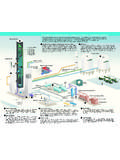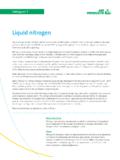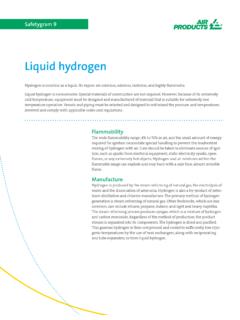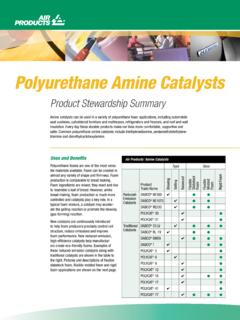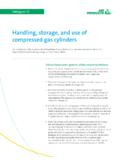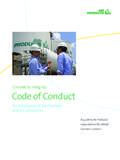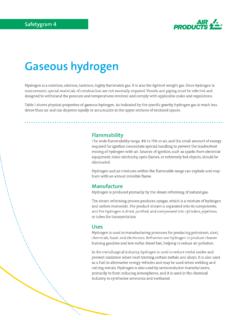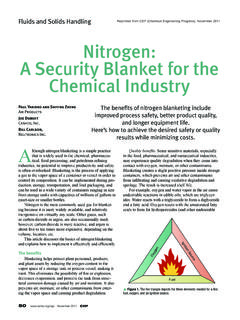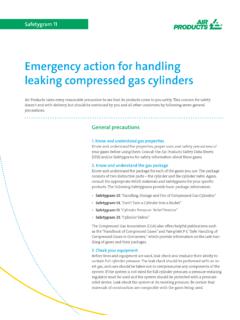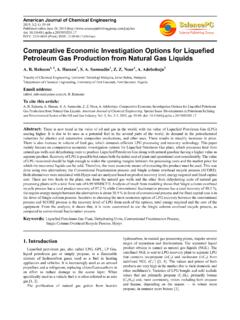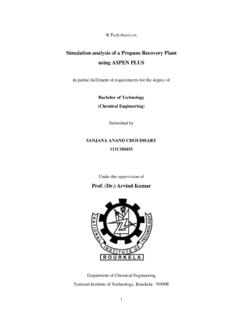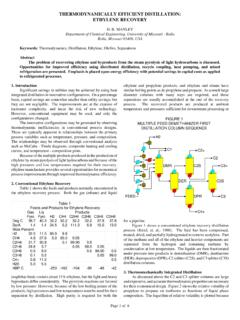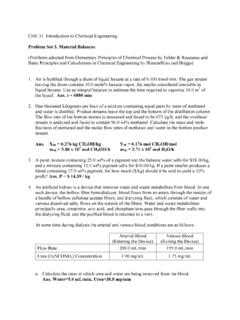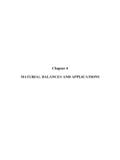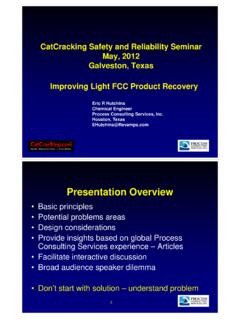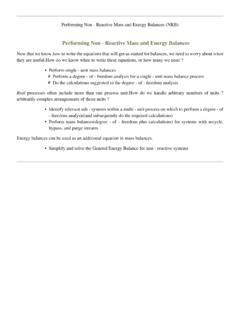Transcription of THE ROAD TO RECOVERY - Air Products & Chemicals
1 REPRINTED FROM JANUARY 2015 LNGINDUSTRY Mixed refrigerant (MR) processes are used in the majority of baseload natural gas liquefaction facilities. Their high efficiency, attractive capital cost, operational flexibility and simple controllability have made these processes the workhorse in the industry. Dual MR processes are often chosen for larger capacity floating LNG (FLNG) applications due to their smaller footprint and low refrigerant inventory. These processes benefit from having very low losses of refrigerant during normal operation and the ability to retain refrigerants within the system during short outages. However, environmental considerations and the potential need to import refrigerants to remote locations may make it desirable to recover and store refrigerants during extended outages or extended turndown operation.
2 Nitrogen recycle processes have also gained prominence in the industry, particularly for FLNG applications in the 1 - 2 million tpy capacity range. These processes can be equipped to liquefy nitrogen for storage and eventual use when changing rates or after outages or turndown periods. This article discusses the benefits of and options for conserving and recovering refrigerants for these processes. Dr. Gowri Krishnamurthy, Mark J. Roberts and Brian K. Johnston, Air Products and Chemicals Inc., USA, examine refrigerant conservation and RECOVERY in LNG ROAD TO LNGINDUSTRY REPRINTED FROM JANUARY 2015 Various MR and nitrogen liquefaction cycles have been employed for the liquefaction of natural gas. These include the propane-precooled MR cycle (AP-C3MR ), dual MR cycle (AP-DMR ), single MR cycle (AP-SMR ), C3MR-Nitrogen hybrid cycle (AP-X ) and N2 recycle process (AP-N ).
3 A majority of these cycles utilise a MR stream, which is typically a mixture of nitrogen, methane, ethane/ethylene and propane, and in some cases includes butanes and isopentane. The composition of the MR stream is optimised based on the cycle configuration and operating conditions. A simplified flow diagram for a natural gas liquefaction facility is shown in Figure 1. The figure shows an AP-C3MR or AP-DMR cycle and a coil wound heat exchanger (CWHE) as the main cryogenic heat exchanger (MCHE). CWHEs are state-of-the-art exchangers for natural gas liquefaction and contain helically wound tube bundles, housed within an aluminium or stainless steel pressurised shell. The MCHE in Figure 1 contains three bundles: warm, middle and cold.
4 Pre-cooled natural gas feed enters at the bottom end of the MCHE, where it is cooled and liquefied as it flows through tubes and exits as LNG. The LNG is let down in pressure and sent to storage. Flash and boil-off gas (BOG) generated during pressure letdown can be compressed and recycled to be mixed with the feed natural gas or used as fuel. The MR is passed through a phase separator to produce a lighter mixed refrigerant vapour (MRV) stream and a heavier mixed refrigerant liquid (MRL) stream. Both streams are cooled in the MCHE tubes. At the top of the middle bundle, the MRL is flashed across a Joule-Thomson (J-T) valve and sent to the shell-side. At the top of the cold bundle, the now liquefied MRV is flashed across a J-T valve and sent to the shell-side.
5 The MRL and MRV refrigerate the fluids in the tubes as they vaporise in the shell-side. The warm low pressure MR stream from the MCHE is compressed in a series of compressors, cooled, and sent to the phase of refrigerant recoveryOften, C2 - C5 refrigerant components can be extracted from the feed natural gas using an NGL RECOVERY system, either integrated with, or prior to, natural gas liquefaction. However, in some cases, refrigerants are imported into the liquefaction facility. This includes scenarios where the feed is lean in NGL components or when plot space is at a premium, such as in FLNG facilities. In such Figure 1. General schematic of natural gas liquefaction 2. Reclamation column for mixed refrigerant 1. Case study resultsShell-side refrigerant from MCHEO verhead vapourBottoms liquidLNG to condenserPartially vaporised LNG from condenserPressure (barg) ( C) (kgmole/hr) (%) + FROM JANUARY 2015 LNGINDUSTRY scenarios, it is advantageous and economical to recover key refrigerant components to minimise the import requirements.
6 Recovering refrigerants is also desirable from an environmental standpoint, since it eliminates or significantly reduces the need for flaring is typically a major component in MR systems. If it is not present in a high enough concentration, allowing easy RECOVERY from the feed, ethylene may be imported for use in the MR system, since ethane may not be conveniently procured externally. Propane and heavier hydrocarbons are less volatile, less likely to be lost and are usually easily procured. However, it is still advantageous to avoid losses. Methane can be easily recovered from the feed natural gas. Make-up nitrogen may be easily obtained, since a nitrogen generator will typically be present in the facility for purging and inerting purposes.
7 Thus, recovering ethane and heavier hydrocarbons from MR may be advantageous from economic and environmental standpoints. During turndown, it is advantageous to remove and store refrigerants for future use. During an extended shutdown, heat leaking into the MCHE will eventually cause an increase in pressure, and it is beneficial to remove methane and nitrogen, recover ethane and heavier components, as well as provide cooling to the MCHE in order to control the nitrogen recycle processes, liquefying a portion of the nitrogen refrigerant for storage and eventual reuse can reduce the size of the nitrogen generator. This can be particularly advantageous for FLNG, where plot space is at a to recover and conserve refrigerantsReclamation columnKey MR components can be recovered and conserved using a reclamation column, as shown in Figure 2.
8 During an extended shutdown or turndown, some refrigerant can be removed from the shell-side of the MCHE and sent to a multi-stage reclamation column that separates the light and heavy refrigerant components to produce an overhead vapour stream and a bottoms liquid stream. The overhead stream consists of light components, such as methane and nitrogen, but is largely free of the valuable ethane and heavier refrigerant components. It typically contains less than approximately 1% ethane and higher hydrocarbons and can be sent to the fuel gas header. The bottoms liquid stream mainly contains the recovered ethane, heavier components and typically less than 10% methane and nitrogen. The bottoms stream is then either returned to the shell-side of the MCHE, sent to a RECOVERY drum, or stored temporarily at the bottom of the reclamation column.
9 The overhead stream from the column is partially condensed against a cold LNG stream and is then separated to produce an ethane-free vapour stream and liquid reflux for the reclamation column. The cold LNG stream is vaporised in the condenser and can be used as fuel, or compressed and recycled to the feed or returned to the LNG tank. Vapour-phase refrigerants in recycle cyclesExpander cycles employing vapour phase nitrogen refrigerant are commonly used to provide the cooling required to liquefy natural gas. The N2 recycle process shown in Figure 3 includes the capability of liquefying a portion of the nitrogen. Nitrogen is compressed, cooled, expanded and used to provide refrigeration to cool and liquefy natural gas. The refrigeration produced is matched to the refrigeration needed for liquefaction by the following two methods: For small changes, the N2 flowrate can be changed.
10 For large changes, the N2 compressor suction pressure is changed; lowered for less refrigeration, increased for Figure 3. Refrigerant RECOVERY in nitrogen recycle 4. External shutoff valve. LNGINDUSTRY REPRINTED FROM JANUARY 2015 more refrigeration. The pressure is changed by adding or removing N2 from remove N2 during turndown operation, a portion of high pressure nitrogen is sent through to the MCHE and liquefied to make liquefied nitrogen (LIN), which is sent to storage for future use. To reintroduce N2 and increase the N2 compressor suction pressure, LIN from storage is vaporised and returned to the suction of the nitrogen compressor. A similar arrangement may be employed for a methane expander cycle for natural gas liquefaction.
